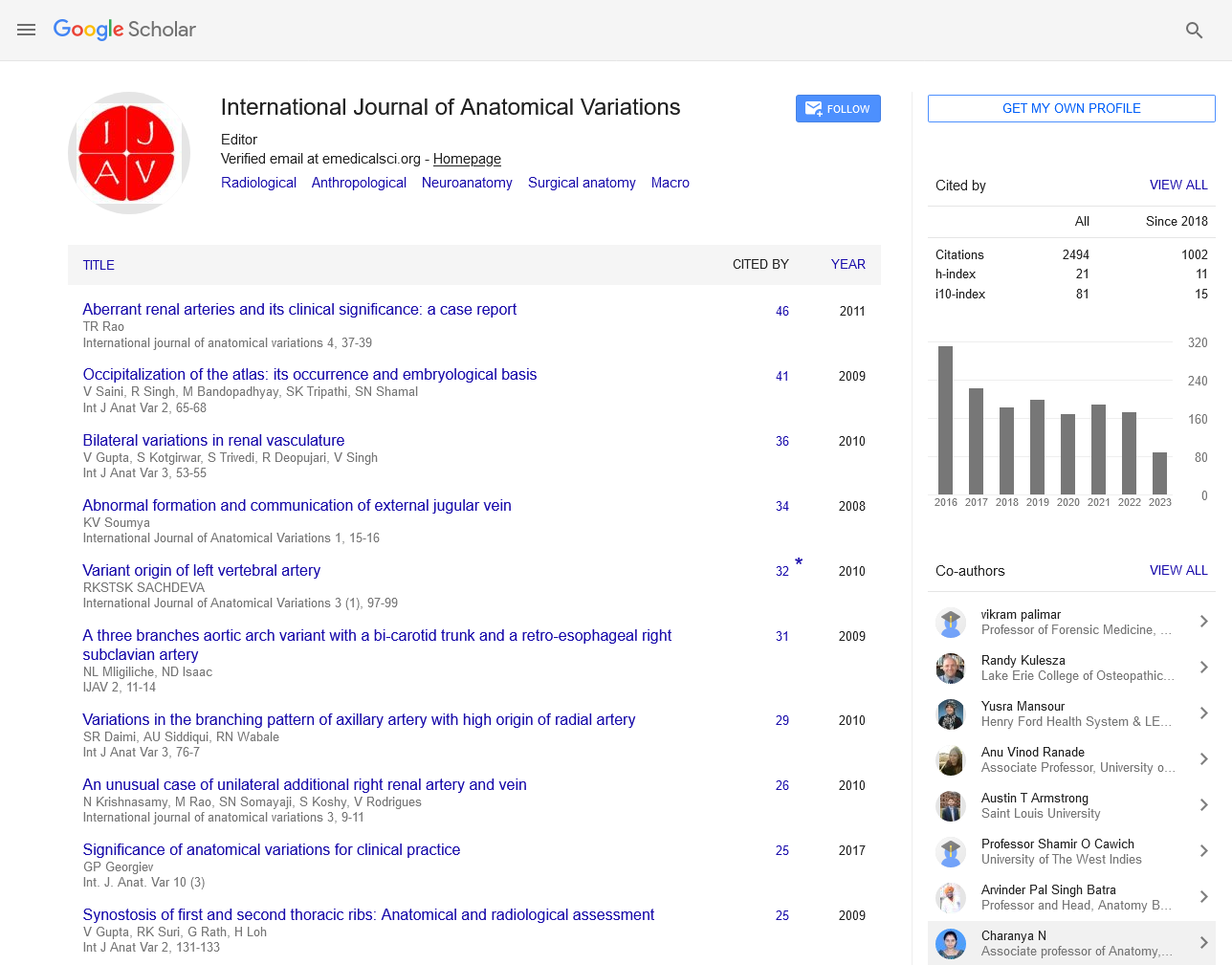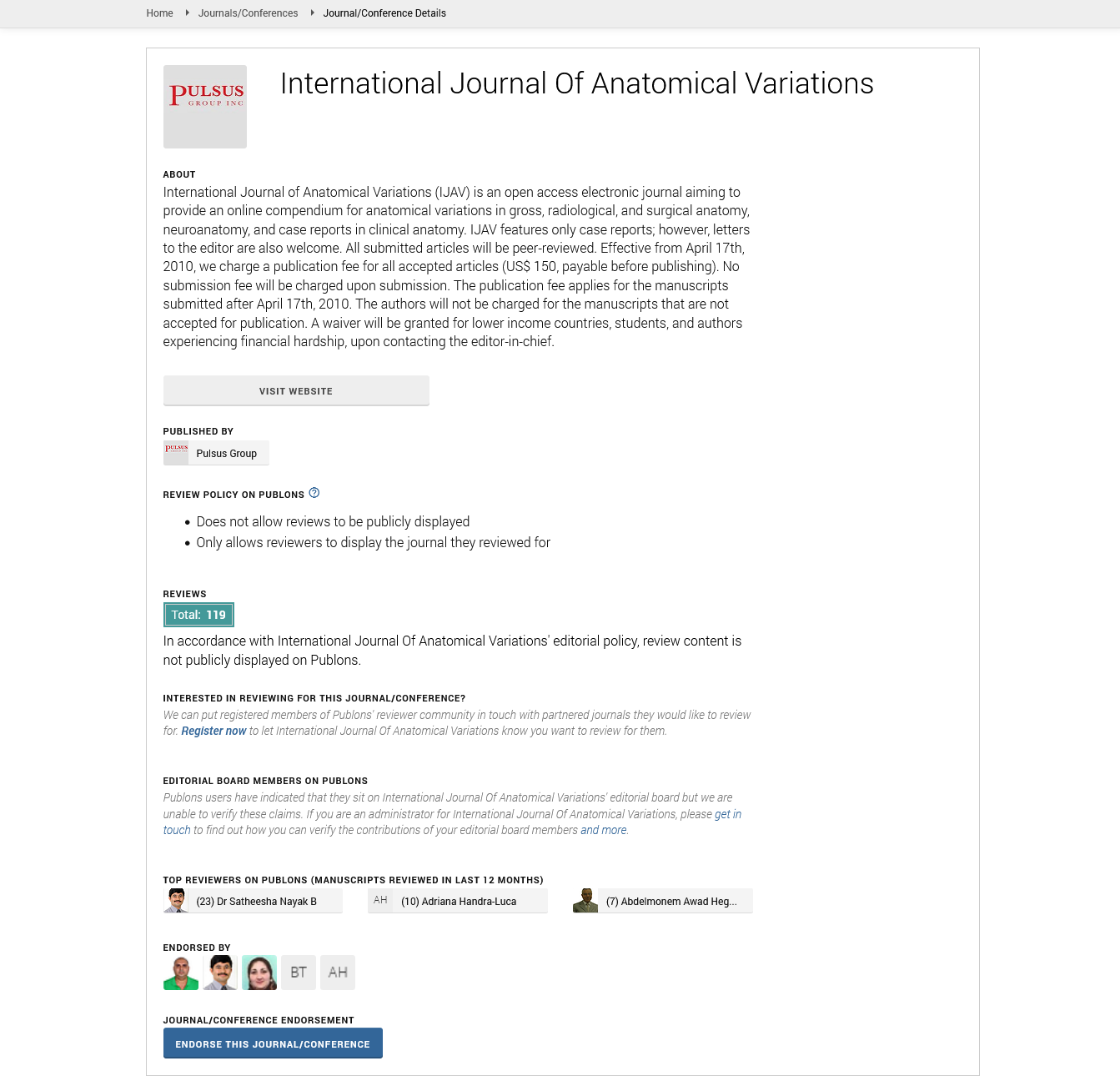Duplicated or Divided Fibular Artery in Lower Limb Vascularization: Anatomical Variations and Clinical Implications
Received: 02-Dec-2024, Manuscript No. ijav-24-7354; Editor assigned: 04-Dec-2024, Pre QC No. ijav-24-7354 (PQ); Reviewed: 18-Dec-2024 QC No. ijav-24-7354; Revised: 26-Dec-2024, Manuscript No. ijav-24-7354 (R); Published: 31-Dec-2024, DOI: 10.37532/1308-4038.17(12).461
Citation: Nakamura S. Duplicated or Divided Fibular Artery in Lower Limb Vascularization Anatomical Variations and Clinical Implications. Int J Anat Var. 2024;17(12): 691-692
This open-access article is distributed under the terms of the Creative Commons Attribution Non-Commercial License (CC BY-NC) (http://creativecommons.org/licenses/by-nc/4.0/), which permits reuse, distribution and reproduction of the article, provided that the original work is properly cited and the reuse is restricted to noncommercial purposes. For commercial reuse, contact reprints@pulsus.com
Abstract
The fibular artery, a branch of the posterior tibial artery, plays a crucial role in the vascularization of the lower limb, supplying blood to the muscles and structures of the lateral compartment of the leg, as well as contributing to the foot and ankle circulation. Variations in the anatomy of the fibular artery, such as duplication or division, are relatively uncommon but have significant implications for clinical practice, especially in the context of surgical procedures, traumatic injuries, and vascular pathologies. This article examines the anatomical variations of the fibular artery, particularly its duplication or division, and discusses the clinical and surgical implications of these variations for lower limb vascularization. Understanding these variations is essential for improving diagnostic accuracy and optimizing surgical outcomes in procedures involving the lower limb vasculature.
Keywords
Fibular artery; Duplication; Divided fibular artery; Lower limb vascularization; Posterior tibial artery; Anatomical variations; Vascular surgery; Leg anatomy
INTRODUCTION
The vascularization of the lower limb is a complex and highly variable system involving several major arteries, including the femoral, popliteal, tibial, and fibular arteries. The fibular artery, also known as the peroneal artery, arises from the posterior tibial artery and provides blood supply to the lateral compartment of the leg and contributes to the lateral aspect of the ankle and foot. Although the fibular artery is typically a single vessel, anatomical variations such as duplication or division of the artery have been documented in various studies. These variations can have significant implications for both normal lower limb function and surgical interventions. The fibular artery plays a crucial role in supplying oxygenated blood to the muscles of the leg and contributing to the blood flow to the foot, particularly in the case of peripheral arterial disease (PAD) and other vascular conditions. Understanding the anatomical variations of the fibular artery, particularly its duplication or division, is essential for clinicians and surgeons who deal with vascular or orthopedic surgeries, trauma management, and diagnostic imaging of the lower limb. This article explores these anatomical variations in detail, examining their prevalence, clinical significance, and the impact they have on the vascularization of the lower limb [1].
NORMAL ANATOMY OF THE FIBULAR ARTERY
The fibular artery typically arises from the posterior tibial artery, one of the two terminal branches of the popliteal artery, and is located in the posterior compartment of the leg. It descends laterally, along the tibia and fibula, and branches into smaller vessels that supply the muscles of the lateral compartment, including the fibularis longus and fibularis brevis. Additionally, the fibular artery contributes to the vascularization of the foot through its terminal branches, including the lateral tarsal artery and the lateral malleolar branches. In its typical configuration, the fibular artery gives off multiple muscular branches that supply the muscles of the lower leg, including the fibular group, and provides blood to the ankle joint. The artery does not directly supply the foot or the anterior compartment of the leg, with the anterior tibial artery and posterior tibial artery providing the majority of the foot's blood supply [2].
ANATOMICAL VARIATIONS DUPLICATED AND DIVIDED FIBULAR ARTERIES
Variations in the fibular artery, including duplication or division, are relatively rare but have been reported in both cadaveric studies and clinical imaging. These variations can result from developmental anomalies during embryogenesis or from adaptive vascular remodeling in response to injury, disease, or surgical interventions.
Duplicated Fibular Artery
A duplicated fibular artery refers to the presence of two fibular arteries, which may arise from the posterior tibial artery at different points or as branches of the same trunk. Duplication can occur at any point along the course of the fibular artery, and the two vessels may travel parallel to each other or may diverge into separate branches that supply different regions of the leg or foot [3]. The prevalence of a duplicated fibular artery varies between studies, with some reports suggesting it occurs in approximately 2-10% of the population. The duplicated artery may be fully functional, with both arteries contributing to the vascularization of the lower leg, or one of the arteries may be smaller and less significant. The clinical relevance of a duplicated fibular artery is particularly important in surgical and diagnostic settings, as the presence of an additional artery may complicate procedures such as ankle surgeries, lower limb amputations, or bypass surgeries.
Clinical Implications of Duplicated Fibular Artery
The presence of a duplicated fibular artery may affect the blood supply to the lateral compartment of the leg and foot. In cases of peripheral arterial disease (PAD), where blood flow is compromised, the presence of a duplicated fibular artery could provide an alternative route for circulation, potentially improving vascular perfusion to the distal regions of the lower limb. However, the duplication could also complicate surgical procedures, especially those involving the removal of vascular lesions, aneurysms, or grafting. During surgery, a duplicated fibular artery may be mistakenly mistaken for an additional vein or other vessel, leading to inadvertent damage or unintended ligation [4]. Furthermore, if one of the duplicated arteries is smaller or functionally inadequate, there could be an increased risk of ischemia in the affected region, especially during traumatic events or vascular occlusion.
Divided Fibular Artery
A divided fibular artery occurs when the fibular artery branches into two or more separate vessels early in its course, creating multiple arteries that serve distinct regions of the lower leg or foot. This division of the fibular artery may occur within the posterior tibial artery or after the artery has already descended into the leg. The divided vessels may follow different pathways, providing blood to different muscle groups or areas of the foot, and could be associated with varying degrees of anastomosis with other arterial systems, such as the anterior tibial artery or the deep fibular artery.
The prevalence of a divided fibular artery is less frequently reported than the duplication of the artery, and its occurrence is often found incidentally during dissection or imaging [5]. The degree of division and the course of the separate branches can vary considerably between individuals, with some cases exhibiting a clear bifurcation or trifurcation of the artery, while others may present with more subtle or diffuse branching patterns.
Clinical Implications of Divided Fibular Artery
The divided fibular artery can have profound clinical consequences. If the division occurs early in the arterial course, it can lead to more complex vascular networks that may be more prone to aneurysmal dilation or pathological changes such as arterial stenosis. The altered vascular anatomy may complicate surgical approaches, particularly when addressing traumatic injuries or conducting procedures such as revascularization or limb salvage surgeries. A divided fibular artery may also increase the complexity of diagnostic imaging, particularly in patients undergoing angiography or magnetic resonance angiography (MRA). The presence of multiple arterial branches may obscure the clear delineation of blood flow patterns, potentially leading to misdiagnosis or difficulties in planning surgical interventions [6].
EMBRYOLOGICAL DEVELOPMENT OF THE FIBULAR ARTERY AND VARIATIONS
The development of the fibular artery begins during fetal life when the posterior tibial artery forms and begins to send branches to the lateral and posterior compartments of the leg. The fibular artery typically arises as a single branch from the posterior tibial artery. However, developmental anomalies during vascular embryogenesis can lead to variations in its formation, including duplication or division. Factors such as altered hemodynamic forces or changes in blood flow may influence how the artery branches and develops during embryonic growth. Although anatomical variations in the fibular artery are typically benign, the presence of a duplicated or divided fibular artery may be associated with a greater risk of vascular anomalies or complications in the future. These variations may also be an adaptive response to increased blood flow demands in the leg or foot, or they may reflect underlying genetic predispositions that affect vascular development [7].
CLINICAL SIGNIFICANCE AND IMPLICATIONS
Understanding the variations in the fibular artery, particularly its duplication or division, is important for both clinical practice and surgical interventions. The clinical significance of these anatomical variations is highlighted in the following contexts
Vascular Surgery
Surgeons performing lower limb bypass procedures, revascularization, or amputation surgeries must account for variations in the fibular artery to avoid inadvertent injury. During procedures that involve vessel grafting, understanding the pattern of vascularization and the potential for multiple arterial branches is crucial for ensuring adequate perfusion of the distal limb. Moreover, any abnormal vascular anatomy should be identified preoperatively through diagnostic imaging, such as Doppler ultrasound, angiography, or MRA [8].
Trauma and Limb Salvage
In traumatic lower limb injuries, such as fractures or vascular damage from accidents, recognizing the presence of duplicated or divided fibular arteries can be vital in ensuring that vascular injuries are properly managed. Damage to the fibular artery can lead to ischemia, and knowledge of collateral circulation provided by additional arterial branches may influence decisions related to limb salvage or the need for grafting.
Peripheral Arterial Disease (PAD)
In the context of PAD, understanding the variations in the fibular arteryâ??s anatomy may help clinicians identify alternative sources of blood supply to the foot and distal lower limb, which may be critical in managing patients with chronic ischemia or ulcers.
CONCLUSION
Duplicated and divided fibular arteries represent important anatomical variations that can significantly influence the vascularization of the lower limb. These variations, though rare, have notable clinical implications in the context of vascular surgeries, traumatic injuries, peripheral arterial diseases, and diagnostic imaging. Surgeons and clinicians must be aware of these variations to avoid complications during procedures and ensure optimal outcomes for patients with lower limb vascular conditions. Comprehensive knowledge of the fibular arteryâ??s variations and their clinical significance is essential for improving patient care in both elective and emergency settings.
REFERENCES
Indexed at, Google Scholar, Crossref
Indexed at, Google Scholar, Crossref
Indexed at, Google Scholar, Crossref
Indexed at, Google Scholar, Crossref
Indexed at, Google Scholar, Crossref
Indexed at, Google Scholar, Crossref
Indexed at, Google Scholar, Crossref
- Polguj M. The subscapularis tendon: a proposed classification system. Ann Anat. 2021; 233:151-615.
- Olewnik Å. Unknown variant of the accessory subscapularis muscle?. Anat Sci Int. 97(1), 138-142.
- Krakhmaleva DA. Mechanisms of corneal neovascularization and modern options for its suppression. Vestn Oftalmo. 2016; 132(4):81-87.
- Kameda Y. An anomalous muscle (accessory subscapularis teres latissimus muscle) in the axilla penetrating the brachial plexus in man. Acta Anat. 1976; 96:513-533.
- Youdas JW. Bilateral presence of a variant subscapularis muscle. Int J Anat Var. 2017; 10(4):79-80.
- Babinski MA. Accessory subscapularis muscle–A forgotten variation?. Morphologie. 2017; 101(333):101-104.
- Christian J. Commentary: Thoracic surgery residency: Not a spectator sport. J Thorac Cardiovasc Surg. 2020 Jun; 159(6):2345-2346.
- Shigeru H. Glomerular Neovascularization in Nondiabetic Renal Allograft Is Associated with Calcineurin Inhibitor Toxicity. Nephron. 2020; 144 Suppl 1:37-42.






